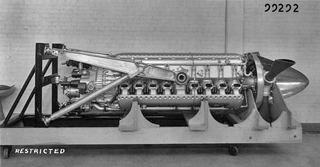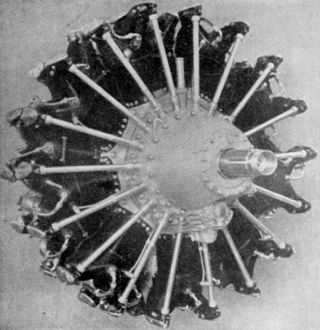
The Napier Sabre is a British H-24-cylinder, liquid-cooled, sleeve valve, piston aero engine, designed by Major Frank Halford and built by D. Napier & Son during World War II. The engine evolved to become one of the most powerful inline piston aircraft engines in the world, developing from 2,200 hp (1,600 kW) in its earlier versions to 3,500 hp (2,600 kW) in late-model prototypes.

The Pratt & Whitney R-1690 Hornet was a widely used American aircraft engine. Developed by Pratt & Whitney, 2,944 were produced from 1926 through 1942. It first flew in 1927. It was a single-row, 9-cylinder air-cooled radial design. Displacement was 1,690 cubic inches. It was built under license in Italy as the Fiat A.59. In Germany, the BMW 132 was a developed version of this engine. The R-1860 Hornet B was an enlarged version produced from 1929.

The Junkers Jumo 213 was a World War II-era V-12 liquid-cooled aircraft engine, a development of Junkers Motoren's earlier design, the Jumo 211. The design added two features, a pressurized cooling system that required considerably less cooling fluid which allowed the engine to be built smaller and lighter, and a number of improvements that allowed it to run at higher RPM. These changes boosted power by over 500 hp and made the 213 one of the most sought-after Axis engine designs in the late-war era.

The Shvetsov ASh-82 (M-82) is a Soviet 14-cylinder, two-row, air-cooled radial aircraft engine developed from the Shvetsov M-62. The M-62 was the result of development of the M-25, which was a licensed version of the Wright R-1820 Cyclone.

The Chrysler XIV-2220 was an experimental 2,500 hp, 2,220 cubic inch liquid-cooled inverted-V-16 World War II aircraft engine. Although several aircraft designs had considered using it, by the time it was ready for use in 1945 the war was already over. Only a few engines were built by Chrysler during a program that started in 1940, and it retained its 'X' designation the entire time as the XIV-2220, later XI-2220. The IV-2220 is historically important as it was Chrysler's first hemi, a design that would re-appear in late-1950’s Chrysler luxury performance automobiles, make drag racing headlines in the 1960s, and continue into the 2000s.

The Republic XP-72 was an American prototype fighter-interceptor developed by Republic Aircraft as a progression of the P-47 Thunderbolt design. The XP-72 was designed around the Pratt & Whitney R-4360 Wasp Major 28-cylinder air-cooled radial engine with a supercharger mounted behind the pilot and driven by an extension shaft from the engine. The armament consisted of six .50 caliber (12.7 mm) wing-mounted Browning AN/M2 machine guns and underwing racks for two 1,000 lb bombs; Alternative armament packages included two 37 mm M4 autocannons with four .50 caliber AN/M2s, or four M4 autocannons.

The Daimler-Benz DB 605 is a German aircraft engine built during World War II. Developed from the DB 601, the DB 605 was used from 1942 to 1945 in the Messerschmitt Bf 109 fighter, and the Bf 110 and Me 210C heavy fighters.

The Rolls-Royce Eagle Mk XXII is a British 24-cylinder, sleeve valve, H-block aero engine of 46 litre displacement. It was designed and built in the early-1940s by Rolls-Royce Limited and first ran in 1944. It was liquid-cooled, of flat H configuration with two crankshafts and was capable of 3,200 horsepower at 18 psi boost.

The Klimov M-105 was a V12 liquid-cooled piston aircraft engine used by Soviet aircraft during World War II.

The Allison V-3420 was a large experimental piston aircraft engine, designed in 1937 by the American Allison Engine Company.

The Fiat A.80 was an 18-cylinder, twin-row, air-cooled, radial aircraft engine produced during World War II. Rated at 1,000 hp (745 kW), it was a more powerful development of the 14-cylinder Fiat A.74.

The Fiat A.74 was a two-row, fourteen-cylinder, air-cooled radial engine produced in Italy in the 1930s as a powerplant for aircraft. It was used in some of Italy's most important aircraft of World War II.

The Fiat AS.6 was an unusual Italian 24-cylinder, liquid-cooled V configured aircraft racing engine designed and built in the late-1920s by Fiat especially for the Schneider Trophy air races, but development and running problems meant that it was never able to compete. Although the engine suffered from technical problems, it was later used to set a speed record for piston-powered seaplanes that still stands today.
The Fiat AS.5 was an Italian 12-cylinder, liquid-cooled V engine designed and built in the late-1920s by Fiat especially for the 1929 Schneider Trophy air race.

The Asso XI was a family of water-cooled, supercharged V12 piston aeroengines produced in the 1930s by Italian manufacturer Isotta Fraschini, and fitted on a number of aircraft types built by CANT, Caproni and others.

The Kawasaki Ha40, also known as the Army Type 2 1,100 hp Liquid Cooled In-line and Ha-60, was a license-built Daimler-Benz DB 601Aa 12-cylinder liquid-cooled inverted-vee aircraft engine. The Imperial Japanese Army Air Service (IJAAS) selected the engine to power its Kawasaki Ki-61 fighter.

The Packard X-2775 was an American experimental liquid-cooled aircraft engine. The engine was constructed as a single crankcase with four banks of six cylinders in what is close to an X-configuration. The engine consisted of two 60° V12 engines, one upright and one inverted, sharing a common crankcase. Although technically incorrect, the engine has been characterized as two Packard 1A-1500 V-12 engines coupled with a mutual crankcase.

The Isotta Fraschini Zeta was an air cooled X engine with 24 cylinders developed by the Italian engineering company Isotta Fraschini in the 1940s. It was developed as an indigenous alternative to the imported Daimler-Benz DB 605 that was being built under licence as the Fiat RA.1050 R.C.58 Tifone. The engine was essentially two Gamma V12 engines on a single crankshaft, but proved troublesome to develop and never entered production.

The Fiat A.82 was an air cooled radial engine with 18 cylinders developed by the Italian engineering company Fiat and produced in small numbers during World War II. It was one of the most powerful aircraft engines produced in Italy and the culmination of series of successively larger engines developed from the A.74. It was used as the power plant for one operational aircraft, the Fiat BR.20bis bomber.

The Isotta Fraschini Asso Caccia, a.k.a. Isotta Fraschini Asso-450 Caccia, was an air-cooled, supercharged V12 piston aero engine produced in the late 1920s and early 1930s by Italian manufacturer Isotta Fraschini.




















